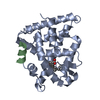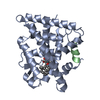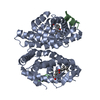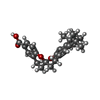Entry Database : PDB / ID : 5lyqTitle Crystal structure of the Retinoic Acid Receptor alpha in complex with a synthetic spiroketal agonist and a fragment of the TIF2 co-activator. HIS-LYS-ILE-LEU-HIS-ARG-LEU-LEU-GLN-ASP Retinoic acid receptor RXR-alpha Keywords / / / Function / homology Function Domain/homology Component
/ / / / / / / / / / / / / / / / / / / / / / / / / / / / / / / / / / / / / / / / / / / / / / / / / / / / / / / / / / / / / / / / / / / / / / / / / / / / / / / / / / / / / / / / / / / / / / / / / / / / / / / / / / / / / / / / / / / / / / / / / / / / / / / / / / / / / / / / / / / / / / / / / / / / / / / / / / / / / / / / / Biological species Homo sapiens (human)Method / / Resolution : 2.17 Å Authors Andrei, S.A. / Ottmann, C. Funding support Organization Grant number Country NWO ECHO 711011017
Journal : Angew. Chem. Int. Ed. Engl. / Year : 2017Title : Designed Spiroketal Protein Modulation.Authors : Scheepstra, M. / Andrei, S.A. / Unver, M.Y. / Hirsch, A.K.H. / Leysen, S. / Ottmann, C. / Brunsveld, L. / Milroy, L.G. History Deposition Sep 28, 2016 Deposition site / Processing site Revision 1.0 Apr 26, 2017 Provider / Type Revision 1.1 May 10, 2017 Group Revision 1.2 Sep 13, 2017 Group / Category / Item Revision 1.3 Aug 10, 2022 Group / Derived calculationsCategory database_2 / pdbx_struct_assembly ... database_2 / pdbx_struct_assembly / pdbx_struct_assembly_gen / pdbx_struct_assembly_prop / pdbx_struct_oper_list Item _database_2.pdbx_DOI / _database_2.pdbx_database_accession ... _database_2.pdbx_DOI / _database_2.pdbx_database_accession / _pdbx_struct_assembly.details / _pdbx_struct_assembly.method_details / _pdbx_struct_assembly.oligomeric_count / _pdbx_struct_assembly.oligomeric_details Revision 1.4 Jan 17, 2024 Group / Refinement descriptionCategory / chem_comp_bond / pdbx_initial_refinement_model
Show all Show less
 Yorodumi
Yorodumi Open data
Open data Basic information
Basic information Components
Components Keywords
Keywords Function and homology information
Function and homology information Homo sapiens (human)
Homo sapiens (human) X-RAY DIFFRACTION /
X-RAY DIFFRACTION /  MOLECULAR REPLACEMENT / Resolution: 2.17 Å
MOLECULAR REPLACEMENT / Resolution: 2.17 Å  Authors
Authors Netherlands, 1items
Netherlands, 1items  Citation
Citation Journal: Angew. Chem. Int. Ed. Engl. / Year: 2017
Journal: Angew. Chem. Int. Ed. Engl. / Year: 2017 Structure visualization
Structure visualization Molmil
Molmil Jmol/JSmol
Jmol/JSmol Downloads & links
Downloads & links Download
Download 5lyq.cif.gz
5lyq.cif.gz PDBx/mmCIF format
PDBx/mmCIF format pdb5lyq.ent.gz
pdb5lyq.ent.gz PDB format
PDB format 5lyq.json.gz
5lyq.json.gz PDBx/mmJSON format
PDBx/mmJSON format Other downloads
Other downloads https://data.pdbj.org/pub/pdb/validation_reports/ly/5lyq
https://data.pdbj.org/pub/pdb/validation_reports/ly/5lyq ftp://data.pdbj.org/pub/pdb/validation_reports/ly/5lyq
ftp://data.pdbj.org/pub/pdb/validation_reports/ly/5lyq
 F&H Search
F&H Search Links
Links Assembly
Assembly

 Components
Components Homo sapiens (human) / Gene: RXRA, NR2B1 / Production host:
Homo sapiens (human) / Gene: RXRA, NR2B1 / Production host: 
 Homo sapiens (human) / References: UniProt: Q15596*PLUS
Homo sapiens (human) / References: UniProt: Q15596*PLUS X-RAY DIFFRACTION / Number of used crystals: 1
X-RAY DIFFRACTION / Number of used crystals: 1  Sample preparation
Sample preparation ROTATING ANODE / Type: RIGAKU MICROMAX-003 / Wavelength: 1.54178 Å
ROTATING ANODE / Type: RIGAKU MICROMAX-003 / Wavelength: 1.54178 Å Processing
Processing MOLECULAR REPLACEMENT
MOLECULAR REPLACEMENT Movie
Movie Controller
Controller


 PDBj
PDBj













